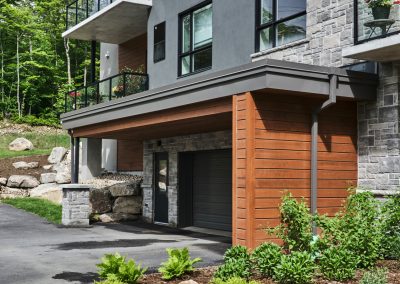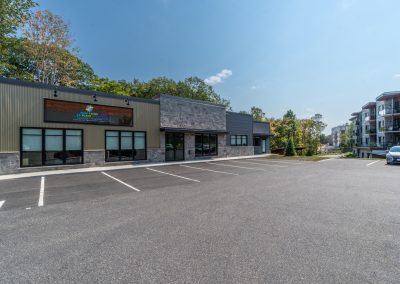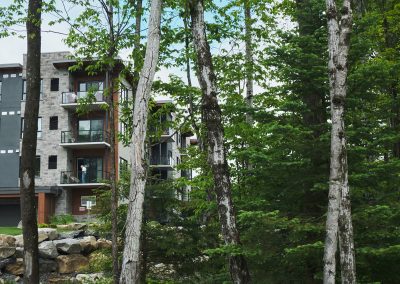
2023 MultiFamily Low-Rise
1st Runner-Up
The Tom in Huntsville, Ontario, Canada, is a condominium built using the Amvic Building System, now known as Alleguard. The project consists of three floors at just under 14,000 square feet per floor, plus a parking garage. The project used 28,492 square feet of exterior ICF blocks along with 12,213 square feet for shear walls, stairwells, elevator walls, and demising walls. The total square footage of ICF used was 43,565. Pat Dubé, a contractor and developer at Greystone Project Management Inc., estimates that two months out of the total 65.7-week construction time was saved by being able to work through the winter, at no additional costs, since the crew can install ICF at the same cost as conventional framing. Even through winter, no additional heating and hoarding was required during the cure.
Responsible Choices
The Tom’s building height was designed to match the dimensions of the ICF block coursing to minimize cuts and material waste. Finished ceiling height was 9 feet. Dubé says the design incorporated larger openings through the use of concrete lintels in ICF walls with minimal cost impact. “ICF walls also acted as shear walls to deal with shear forces in the building without changing material types, and allowed for continuous ICF installation,” he says. “This ultimately reduced the complexity of the build, and reduced time on site as a result of having fewer trades involved, because ICF was used in lieu of traditional masonry walls.”
The site is near a forest and is on a slope, both factors that needed to be taken into consideration. The design optimized the natural surroundings and had half the indoor garage buried underground. Parking garage walls are 12 feet high, and were built with 10-inch ICF blocks with heavy reinforcing.
Lake views and views of the nearby rolling hills were not blocked because the design of the roofline and building height is low enough to stay within the tree canopy so sight lines are not blocked.
Sustainable Design
The use of timber overhangs help to reduce incoming sunlight during summer to reduce cooling costs, and promote incoming sunlight in winter months to promote passive heating and minimize heating costs. All lighting is energy-efficient LEDs. “Taking advantage of ICF and concrete in the design allowed for the use of the material for fire separations, while providing maximum enjoyment for owners through reduced sound transfer between units,” says Dubé.
Energy costs run about $28.33 per month per suite, including common areas which are the parking garage, corridors, and the amenity room. The average Canadian home pays about $632 per suite, according to Canadian newspaper “The Globe and Mail.” Because the construction costs were kept low, the condominium’s selling prices are below the regional average selling price for homes.
Dubé says that at one point they did consider constructing the condos with cold-formed steel walls with coreslab floor systems. “Our main intention for making this shift was to condense the project schedule, and free up human resources to focus on the ICF construction of other projects,” he says. “Ultimately, we decided to abandon this construction method, and stick with ICF because we were reluctant to accept that CFS would perform as well or better than ICF in terms of thermal and acoustical characteristics, even with a potential schedule tradeoff that would reduce construction time by 1 to 2 months. We decided to delay the project schedule and continue to construct with ICF for this project in order to continue to target our condo market buyers with the same level of confidence that our ICF buildings give us.”
More To Come
The Tom is the first of 12 similar and larger buildings that are planned for the campus. The Tom itself is designed and oriented to integrate with the next door building, the Campus Trails Wellness Centre and One Kids Place, which together create the Campus Trails community. The intent of the design is to maximize the natural surroundings and create a neighborhood feel where people can walk and be active while remaining close to home. The Wellness Centre is a place where people can access a full-service pharmacy, two teams of family physicians, and a physical therapy clinic. “We built the Wellness Centre because we want our residents to spend more time enjoying their Muskoka lifestyle, and less time commuting between appointments or seeking health services,” says Dubé. “The design allows seniors to age in place, with a hospital nearby and health care facilities located on site.”
Greystone has been building ICF structures since 1998, and are able to keep costs low because of their experience and proficiency. The success of The Tom helps to ensure success for the remaining planned buildings.
“In the past 10 years, 90% of our projects were constructed with ICF elements, most of which were constructed of ICF from footings to the roof,” says Dubé. “Greystone firmly believes in ICF being a superior product to other construction materials in the life cycle of a construction project, and we are able to realize the long-term benefits without incurring a high capital expense on the project. This makes the ICF construction type our primary choice for most building projects.”
Project Statistics
Location: Huntsville, Ontario, Canada
Type: Condominium
Size: 41,979 sq. ft.
ICF Use: 43,565 sq. ft.
Cost: $9,200,000
Total Construction: 65.7 weeks
ICF Installation Time: 95 days
Construction Team
Owner: Greystone
General Contractor: Greystone
ICF Installer: Greystone
Form Distributor: Amvic
Architect: Duncan Ross Architect
ICF System: Amvic
Fast Facts
- 30-unit residential building with underground parking and amenity room
- Limited to 3 floors due to zoning
- First phase of development of 15 similar buildings
- Concrete was poured in subzero temperatures
- The use of ICF provided an accelerated schedule
Like what you read?
Yearly Subscriptions Starting @ $30



























0 Comments
Trackbacks/Pingbacks